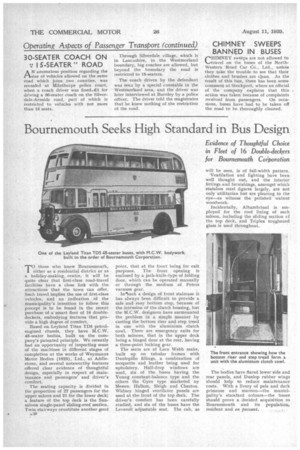Bournemouth Seeks High Standard in Bus Design
Page 48

If you've noticed an error in this article please click here to report it so we can fix it.
Evidence of Thoughtful Choice in Fleet of 16 Double-deckers for Bournemouth Caporation . TO those who know Bournemouth, either as a residential district or as a holiday-making, centre, it will be quite clear that first-class road-travel facilities have a close link with the attraction's that the town can offer. Such travel implies the use of first-class vehicles, and an indication of the municipality's intention to follow this precept is to be found in the recent purchase of a smart fleet of 16 doubledeckers, embodying features that provide a high degree of comfort.
Based on Leyland Titan TD5 petrolengined chassis, they have M.C.W. 48-seater bodies, built on the company's patented principle. We recently had an opportunity of inspecting some of the machines in different stages of completion at the works of Weymanns Motor Bodies (1925), Ltd., at Addlestone, and several noteworthy features offered clear evidence of thoughtful design, especially in respect of maintenance and passengers' and driver's comfort.
The seating capacity is divided in the proportion of 27 passengers for the upper saloon and 21 for the lower deck; a feature of the top deck is the Sunsaloon single-panel sliding-roof section. Twin stairways constitute another good
A38 point, that at the front being for exit purposes. The front opening is enclosed by a jack-knife-type of folding door, which_ can be operated manually or through the medium of Peters vacuum gear.
In'tuch a design of front staircase it has always been difficult to provide a safe and easy bottom step, because of the intrusion of the clutch housing, but the M.C.W. designers have surmounted the problem in a simple manner by casting the bottom riser and step tread in one with the aluminium clutch cowl. There are emergency exits for both saloons, that in the upper deck being a hinged door at the rear, having a three-point locking gear.
The seats are of Lace Webb make, built up on tubular frames with Dunlopillo fillings, a combination of moquette and leather being used for upholstery. Half-drop windows are used, six of the buses having the Young constant-balance type and the others the Gyro type marketed by Messrs, Hallam, Sleigh and Cheston. Widney hinged ventilator panels are used at the front of the top deck. The driver's comfort has been carefully studied, and six of the buses have the Leveroll adjustable seat. The cab, as will be seen, is of full-width pattern.
Ventilation and lighting have been well thought out, and the interior fittings and furnishings, amongst which stainless steel ,figures largely, are not only utilitarian but are pleasing to the eye—as witness the polished walnut woodwork.
Incidentally. Alharribrinal is employed for the roof lining of each saloon, including the sliding section cf the top deck, and Triplex toughened glass is used throughout.
The bodies have flared lower side and rear panels, and Dunlop rubber wings should help to reduce maintenance costs. With a livery of pale and dark primrose and maroon—the municipality's standard colours—the buses should prove a decided acquisition to Bournemouth and its population, resident and en passant.












































































